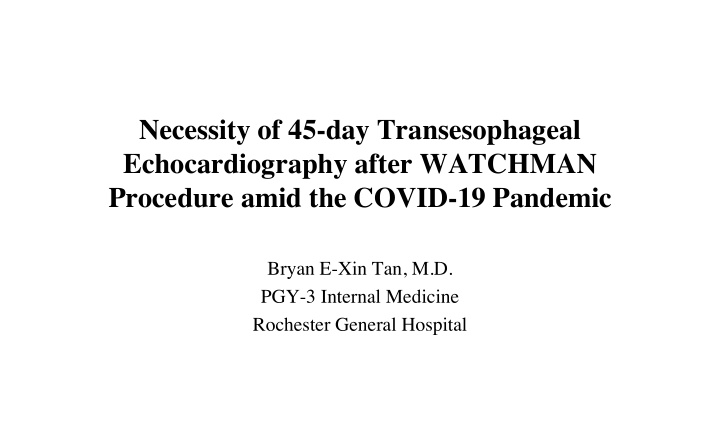



Necessity of 45-day Transesophageal Echocardiography after WATCHMAN Procedure amid the COVID-19 Pandemic Bryan E-Xin Tan, M.D. PGY-3 Internal Medicine Rochester General Hospital
No Conflict of Interest
Necessity of 45-day Transesophageal RESULTS Echocardiography after • Among 189 patients without peri-device flow during procedure, 180 underwent TEE at 45 days, and only 1/180 (0.6%) had significant peri-device WATCHMAN Procedure amid the flow > 5mm. Among 11 patients with peri-device flow 1 – 5mm during COVID-19 Pandemic Incidence of significant peri- procedure, 9 underwent TEE at 45 days, and none (0%) had peri-device flow > 5mm. (Figure 1). No patients had DRT on 45-day TEE. Bryan E-Xin Tan 1 , Jeremiah P. Depta 2 , Bipul Baibhav 2 , Deepak L Bhatt 3 device flow and device-related 1 Department of Internal Medicine, Rochester General Hospital, Rochester, NY. 2 Sands Constellation Heart Institute, Rochester Regional Health, Rochester, thrombus at 45 days post- NY. 2 Brigham and Women’s Hospital Heart & Vascular Center, Harvard Medical School, Boston, MA. BACKGROUND WATCHMAN is very low • Amid the COVID-19 outbreak, elective aerosolizing procedures such as TEE should be deferred as the procedure provokes coughing and gagging, which can cause Our results suggest that oral aerosolization of the virus. • According to American Society of Echocardiography (ASE), anticoagulation may be safely the risks and benefits of performing TEE should be considered for patients who are COVID-19 positive, and discontinued at 45 days without patients who may be asymptomatic. • In atrial fibrillation patients undergoing left atrial appendage Table 1: Baseline and discharge characteristics of patients. Continuous variable presented as TEE mean +/- sd, categorical variable presented as n/N (%) closure (LAAC), TEE is typically performed at 45 days to assess peri-device flow <5mm and an absence of device- related thrombus (DRT) before oral anticoagulation (OAC) is discontinued. Deferring 45-day TEE post- • We sought to investigate whether a 45-day TEE is absolutely necessary for patients who underwent LAAC amid the COVID-19 pandemic. WATCHMAN has the potential METHODS to minimize PPE use & reduce • We retrospectively studied 200 patients who underwent risk of viral transmission amid successful WATCHMAN procedure the Rochester General Hospital (June 2016 - June 2019). the COVID-19 pandemic • All patients were maintained on OAC and aspirin upon discharge until 45-day TEE was performed. Figure 1: Residual peri-device flow during the procedure and at 45 days ( CONCLUSION • We aimed to assess TEE measured peri-device flow at the time of WATCHMAN implantation and at 45 days. • The incidence of significant peri-device flow and DRT at 45 days is very low. 45-day TEE post-WATCHMAN implantation may not be necessary for all • We also aimed to evaluate the incidence of DRT on 45-day patients, and OAC may be safely discontinued at 45 days without a TEE. TEE. • Deferring 45-day TEE post-WATCHMAN implantation has the potential to minimize use of PPEs and reduce preventable risks of viral transmission amid the COVID-19 outbreak.
Background • Amid the COVID-19 outbreak, elective aerosolizing procedures such as TEE should be deferred as the procedure provokes coughing and gagging, which can cause aerosolization of the virus. • According to American Society of Echocardiography (ASE), the risks and benefits of performing TEE should be considered for patients who are COVID-19 positive, and patients who may be asymptomatic. • In atrial fibrillation patients undergoing left atrial appendage closure (LAAC), TEE is typically performed at 45 days to assess peri-device flow <5mm and an absence of device- related thrombus (DRT) before oral anticoagulation (OAC) is discontinued. • We sought to investigate whether a 45-day TEE is absolutely necessary for patients who underwent LAAC amid the COVID-19 pandemic.
Methods • We retrospectively studied 200 patients who underwent successful WATCHMAN procedure the Rochester General Hospital (June 2016 - June 2019). • All patients were maintained on OAC and aspirin upon discharge until 45-day TEE was performed. • We aimed to assess TEE measured peri-device flow at the time of WATCHMAN implantation and at 45 days. • We also aimed to evaluate the incidence of DRT on 45-day TEE.
Results • Among 189 patients without peri-device flow during procedure, 180 underwent TEE at 45 days, and only 1/180 (0.6%) had significant peri-device flow > 5mm. Among 11 patients with peri-device flow 1 – 5mm during procedure, 9 underwent TEE at 45 days, and none (0%) had peri-device flow > 5mm. No patients had DRT on 45-day TEE.
Conclusion • The incidence of significant peri-device flow and DRT at 45 days is very low. 45-day TEE post-WATCHMAN implantation may not be necessary for all patients, and OAC may be safely discontinued at 45 days without a TEE. • Deferring 45-day TEE post-WATCHMAN implantation has the potential to minimize use of PPEs and reduce preventable risks of viral transmission amid the COVID-19 outbreak.
Recommend
More recommend